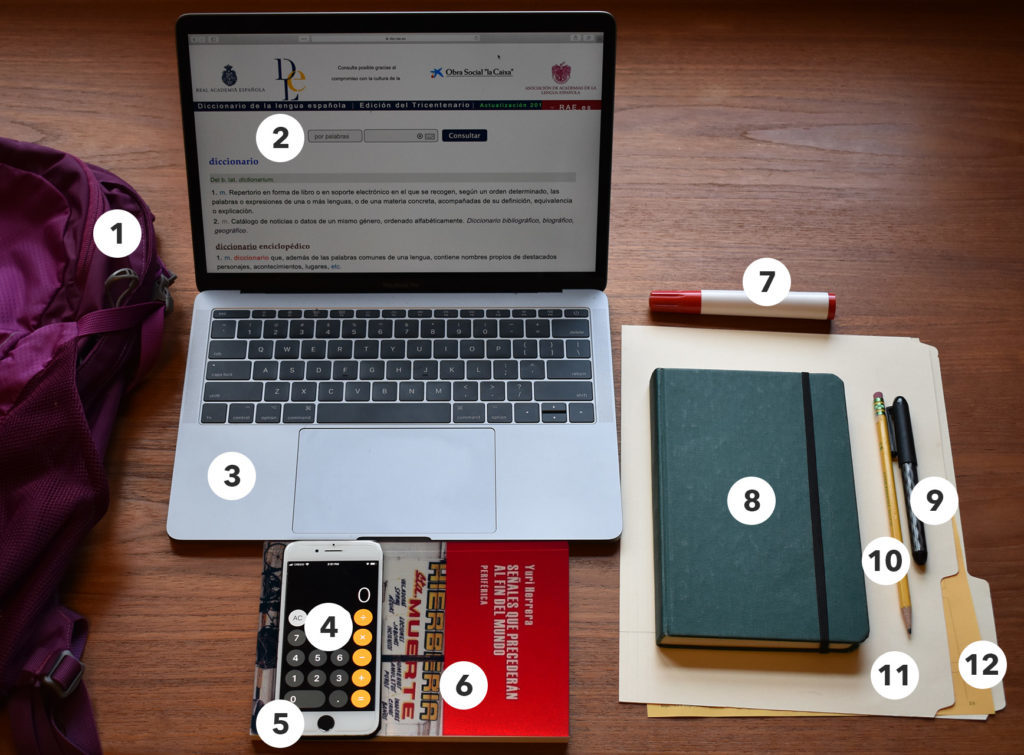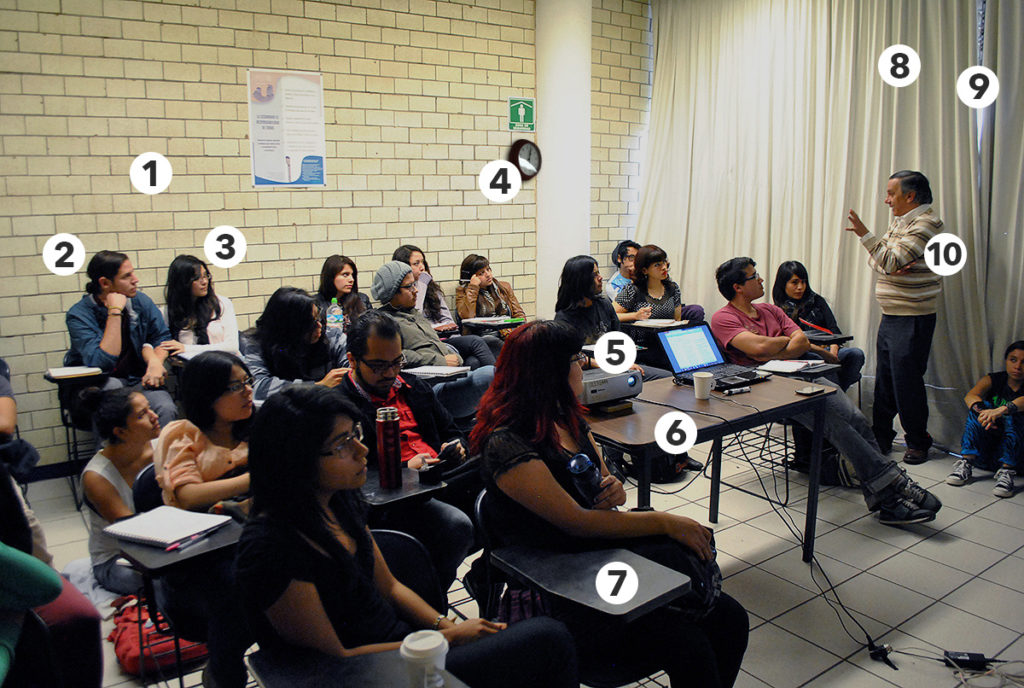1.10: Putting It Together - ¡Hola! ¿Cómo te llamas?
- Page ID
- 262483
\( \newcommand{\vecs}[1]{\overset { \scriptstyle \rightharpoonup} {\mathbf{#1}} } \)
\( \newcommand{\vecd}[1]{\overset{-\!-\!\rightharpoonup}{\vphantom{a}\smash {#1}}} \)
\( \newcommand{\id}{\mathrm{id}}\) \( \newcommand{\Span}{\mathrm{span}}\)
( \newcommand{\kernel}{\mathrm{null}\,}\) \( \newcommand{\range}{\mathrm{range}\,}\)
\( \newcommand{\RealPart}{\mathrm{Re}}\) \( \newcommand{\ImaginaryPart}{\mathrm{Im}}\)
\( \newcommand{\Argument}{\mathrm{Arg}}\) \( \newcommand{\norm}[1]{\| #1 \|}\)
\( \newcommand{\inner}[2]{\langle #1, #2 \rangle}\)
\( \newcommand{\Span}{\mathrm{span}}\)
\( \newcommand{\id}{\mathrm{id}}\)
\( \newcommand{\Span}{\mathrm{span}}\)
\( \newcommand{\kernel}{\mathrm{null}\,}\)
\( \newcommand{\range}{\mathrm{range}\,}\)
\( \newcommand{\RealPart}{\mathrm{Re}}\)
\( \newcommand{\ImaginaryPart}{\mathrm{Im}}\)
\( \newcommand{\Argument}{\mathrm{Arg}}\)
\( \newcommand{\norm}[1]{\| #1 \|}\)
\( \newcommand{\inner}[2]{\langle #1, #2 \rangle}\)
\( \newcommand{\Span}{\mathrm{span}}\) \( \newcommand{\AA}{\unicode[.8,0]{x212B}}\)
\( \newcommand{\vectorA}[1]{\vec{#1}} % arrow\)
\( \newcommand{\vectorAt}[1]{\vec{\text{#1}}} % arrow\)
\( \newcommand{\vectorB}[1]{\overset { \scriptstyle \rightharpoonup} {\mathbf{#1}} } \)
\( \newcommand{\vectorC}[1]{\textbf{#1}} \)
\( \newcommand{\vectorD}[1]{\overrightarrow{#1}} \)
\( \newcommand{\vectorDt}[1]{\overrightarrow{\text{#1}}} \)
\( \newcommand{\vectE}[1]{\overset{-\!-\!\rightharpoonup}{\vphantom{a}\smash{\mathbf {#1}}}} \)
\( \newcommand{\vecs}[1]{\overset { \scriptstyle \rightharpoonup} {\mathbf{#1}} } \)
\( \newcommand{\vecd}[1]{\overset{-\!-\!\rightharpoonup}{\vphantom{a}\smash {#1}}} \)
\(\newcommand{\avec}{\mathbf a}\) \(\newcommand{\bvec}{\mathbf b}\) \(\newcommand{\cvec}{\mathbf c}\) \(\newcommand{\dvec}{\mathbf d}\) \(\newcommand{\dtil}{\widetilde{\mathbf d}}\) \(\newcommand{\evec}{\mathbf e}\) \(\newcommand{\fvec}{\mathbf f}\) \(\newcommand{\nvec}{\mathbf n}\) \(\newcommand{\pvec}{\mathbf p}\) \(\newcommand{\qvec}{\mathbf q}\) \(\newcommand{\svec}{\mathbf s}\) \(\newcommand{\tvec}{\mathbf t}\) \(\newcommand{\uvec}{\mathbf u}\) \(\newcommand{\vvec}{\mathbf v}\) \(\newcommand{\wvec}{\mathbf w}\) \(\newcommand{\xvec}{\mathbf x}\) \(\newcommand{\yvec}{\mathbf y}\) \(\newcommand{\zvec}{\mathbf z}\) \(\newcommand{\rvec}{\mathbf r}\) \(\newcommand{\mvec}{\mathbf m}\) \(\newcommand{\zerovec}{\mathbf 0}\) \(\newcommand{\onevec}{\mathbf 1}\) \(\newcommand{\real}{\mathbb R}\) \(\newcommand{\twovec}[2]{\left[\begin{array}{r}#1 \\ #2 \end{array}\right]}\) \(\newcommand{\ctwovec}[2]{\left[\begin{array}{c}#1 \\ #2 \end{array}\right]}\) \(\newcommand{\threevec}[3]{\left[\begin{array}{r}#1 \\ #2 \\ #3 \end{array}\right]}\) \(\newcommand{\cthreevec}[3]{\left[\begin{array}{c}#1 \\ #2 \\ #3 \end{array}\right]}\) \(\newcommand{\fourvec}[4]{\left[\begin{array}{r}#1 \\ #2 \\ #3 \\ #4 \end{array}\right]}\) \(\newcommand{\cfourvec}[4]{\left[\begin{array}{c}#1 \\ #2 \\ #3 \\ #4 \end{array}\right]}\) \(\newcommand{\fivevec}[5]{\left[\begin{array}{r}#1 \\ #2 \\ #3 \\ #4 \\ #5 \\ \end{array}\right]}\) \(\newcommand{\cfivevec}[5]{\left[\begin{array}{c}#1 \\ #2 \\ #3 \\ #4 \\ #5 \\ \end{array}\right]}\) \(\newcommand{\mattwo}[4]{\left[\begin{array}{rr}#1 \amp #2 \\ #3 \amp #4 \\ \end{array}\right]}\) \(\newcommand{\laspan}[1]{\text{Span}\{#1\}}\) \(\newcommand{\bcal}{\cal B}\) \(\newcommand{\ccal}{\cal C}\) \(\newcommand{\scal}{\cal S}\) \(\newcommand{\wcal}{\cal W}\) \(\newcommand{\ecal}{\cal E}\) \(\newcommand{\coords}[2]{\left\{#1\right\}_{#2}}\) \(\newcommand{\gray}[1]{\color{gray}{#1}}\) \(\newcommand{\lgray}[1]{\color{lightgray}{#1}}\) \(\newcommand{\rank}{\operatorname{rank}}\) \(\newcommand{\row}{\text{Row}}\) \(\newcommand{\col}{\text{Col}}\) \(\renewcommand{\row}{\text{Row}}\) \(\newcommand{\nul}{\text{Nul}}\) \(\newcommand{\var}{\text{Var}}\) \(\newcommand{\corr}{\text{corr}}\) \(\newcommand{\len}[1]{\left|#1\right|}\) \(\newcommand{\bbar}{\overline{\bvec}}\) \(\newcommand{\bhat}{\widehat{\bvec}}\) \(\newcommand{\bperp}{\bvec^\perp}\) \(\newcommand{\xhat}{\widehat{\xvec}}\) \(\newcommand{\vhat}{\widehat{\vvec}}\) \(\newcommand{\uhat}{\widehat{\uvec}}\) \(\newcommand{\what}{\widehat{\wvec}}\) \(\newcommand{\Sighat}{\widehat{\Sigma}}\) \(\newcommand{\lt}{<}\) \(\newcommand{\gt}{>}\) \(\newcommand{\amp}{&}\) \(\definecolor{fillinmathshade}{gray}{0.9}\)See below for a summary of the vocabulary and grammar points you learned this chapter. Review the content as needed to prepare for the assessment to demonstrate your mastery of the objectives in this chapter.
- Vocabulario - Saludos y respuestas
-
*Note: “así así” (so-so) is an expression commonly heard in American movies where Spanish speaking characters are portrayed. However, this expression is not accurate. The accurate way to say that you are “so-so” or “ok” is “más o menos” or “regular“.Hola (Hello) Buenos días (Good morning) Buenas tardes (Good afternoon) Buenas noches (Good evening) ¿Cómo está (usted)? (formal) (How are you?) ¿Cómo estás (tú)? (informal) (How are you?) ¿Qué tal? (informal) How’s it going? Estoy bien. I am well. Estoy muy bien. (I am very well.) Estoy bastante bien. (I am quite well.) Estoy más o menos. (I am ok.) Estoy regular. (I am ok.) Estoy mal. (I’m sick / I’m not doing well.) Gracias, ¿y usted? (formal) (Thank you, and you?) Gracias, ¿y tú? (informal) (Thank you, and you?)
- Vocabulario - Presentaciones
-
¿Cómo se llama usted? (formal) (What is your name?) ¿Cómo te llamas? (informal) (What is your name?) Me llamo… (My name is / I call myself…) Mi nombre es… (My name is…) ¿De dónde es usted? (formal) (Where are you from?) ¿De dónde eres? (informal) (Where are you from?) Soy de Perú. (I am from Peru.) Sr. López, le presento a Pablo. (Mr. Lopez, may I present Pablo / let me introduce you to Pablo.) Le presento a... (formal) (May I present...) Te presento a… (informal) (May I present…) Pedro, te presento a Pablo. (Pedro, may I present Pablo. / Pedro, I’d like to introduce Pablo.) Esta es… (This is… (introducing a female)) Este es… (This is… (introducing a male))
Este es Pablo y esta es María. (This is Pablo and this is María.) Encantado Delighted / Nice to meet you. (say if you are male.) Encantada Delighted/Nice to meet you. (say if you are female.) Encantada de conocerte. (informal) Nice to meet you. El gusto es mío. (The pleasure is mine.) Mucho gusto. (Nice to meet you.) Igualmente. (Same / Likewise.) Sra. (señora) (Mrs.) Sr. (señor) (Mr.) Srta. (señorita) (Miss)
- Vocabulario - Despedidas
-
Adiós. (Goodbye.) Chao. (sometimes spelled chau) (‘Bye.) Hasta luego. (See you later.) Hasta mañana. (See you tomorrow.) Hasta pronto. (See you soon.) ¡Nos vemos! (See you (later)!)
- Vocabulario - En la mochila del estudiante
-

1.la mochila (backpack)
2. el diccionario (dictionary) 3. la computadora (computer) 4. la calculadora (calculator) 5. el teléfono (telephone) 6. el libro (book) 7. el marcador (marker) 8. el cuaderno (notebook) 9. el bolígrafo (pen) 10. el lápiz (pencil) 11. la carpeta (folder/ binder) 12. el papel (paper), la hoja de papel (piece of paper) 13. el escritorio (desk)
- Vocabulario - En la clase
-

1. la pared (wall) 2. el estudiante (student, m) 3. la estudiante (student, f) 4. el reloj (clock) 5. el proyector (projector) 6. la mesa (table) 7. el pupitre (student’s desk) 8. la cortina (curtain) 9. la ventana (window) 10. el profesor, la profesora (professor, m, f)
- Vocabulario - En el salón de clase
-

1. la luz (light) 2. el mapa (map) 3. la pizarra (chalkboard/ whiteboard) 4. la tiza (chalk) 5. la puerta (door) 6. la silla (chair) 7. la basura (trash) Una palabra útil (a useful word):
hay (there is / there are; “hay” is an invariable verb that is only used to talk about the existence or presence, or the quantity of things.)
- Vocabulario - Los números 0-31
-
- 0 cero
- 1 uno
- 2 dos
- 3 tres
- 4 cuatro
- 5 cinco
- 6 seis
- 7 siete
- 8 ocho
- 9 nueve
- 10 diez
- 11 once
- 12 doce
- 13 trece
- 14 catorce
- 15 quince
- 16 dieciséis
- 17 diecisiete
- 18 dieciocho
- 19 diecineuve
- 20 veinte
- 21 veintiuno
- 22 veintidós
- 23 veintitrés
- 24 veinticuatro
- 25 veinticinco
- 26 veintiséis
- 27 veintisiete
- 28 veintiocho
- 29 veintinueve
- 30 treinta
- 31 treinta y uno
- El género y el número de los sustantivos
-
El género de los sustantivos
All nouns in Spanish have a gender: masculine or feminine. Except in the case of people or animals, linguistic gender is a convention of language, not a property of the noun. For this reason, you won’t be able to guess the gender of a noun based on the object itself; you need to learn the gender along with the noun. However, there are some rules that can help you guess the gender of an unknown word.
- The gender of nouns
- Feminine
- The definite article meaning “the” is la for feminine singular nouns.
- Most words ending in –a are feminine.
- All words ending in -sión, -ción, -tad, -dad, and –umbre are feminine.
- Masculine
- The definite article meaning “the” is el for masculine singular nouns. Notice that el without the accent mark is the article… what does él mean? That’s right, it means “he”. Don’t confuse el and él!
- Most words ending in –o are masculine.
- Many but not all words ending in –ma are masculine (the ones that originated from the Greek language are the masculine ones.
- Many nouns end in –e. While statistically more are masculine than feminine, there is no firm rule for these and you need to memorize their gender when learning their meaning.
- Many nouns that end in consonants other than -d or -z are masculine, but again this is not a firm rule and you must memorize their gender.
- There are other nouns that do not clearly reveal their gender, so it is important that you memorize them.
- el pupitre
- el lápiz
- el reloj
- la luz
- la pared
- There are also some exceptions to the above patterns that you have to remember.
- el día
- la mano
- la foto (short for la fotografía)
- la moto (short for la motocicleta)
- Feminine
- The gender of people
- When referring to people, the biological sex of a person will determine a word’s gender regardless of the rules described above. However, as society has become more sensitive to sexism, as well as questions of gender and sexual identity, people have begun experimenting with ways to adjust the traditional binary-gendered structure of the Spanish languages. To find out more, read about Gender neutral language in Spanish.
- Some nouns for people will be identical except for the -o or -a ending
- el muchacho (boy) / la muchacha (girl)
- el niño (male child) / la niña (female child)
- el maestro (male teacher) / la maestra (female teacher)
- el compañero de clase (male classmate) / la compañera de clase (female classmate)
- el amigo (male friend) / la amiga (female friend)
- However, other nouns are completely different for masculine and feminine forms.
- el hombre (man) / la mujer (woman)
- el padre (father) / la madre (mother)
- Some nouns for people are identical, and the gender is shown only in the definite article. ¡OJO! (Careful/Watch out!) A large number of words that identify members of professions or groups end in “-ista” and only distinguish gender by the article; these words end in “-ista” even if masculine.
- el estudiante (male student) / la estudiante (female student)
- el dentista (male dentist) / la dentista (female dentist)
- el optimista (male optimist) la optimista (female optimist)
- el anarquista (male anarchist) la anarquista (female anarchist)
- ¡OJO! The gender of nouns that do not refer to people is an inherent characteristic that cannot be changed. If you change the gender ending of an inanimate object, you can be changing the meaning of the noun to another legitimate word in Spanish.
- el caso (case) / la casa (house)
- el puerto (port) / la puerta (door)
- el Papa (the Pope) / la papa (potato)
- el libro (book) / la libra (pound)
El número de los sustantivos
Nouns can be singular, meaning there is only one or plural, i.e. more than one.
Like English, to make a noun plural in Spanish, you generally add an -s.
- If a word ends in a vowel, add –s (cuaderno – cuadernos, chica – chicas)
- If a word ends in a consonant, add an –es (marcador – marcadores, reloj – relojes)
- If a word ends in -z, change the “z” to c and add –es (lápiz- lápices, luz – luces)
- The gender of nouns
- Los artículos definidos e indefinidos
-
Los artículos definidos
Definite articles refer to specific nouns or nouns that have been previously mentioned. The speaker and listener often have a reference for this noun; they have seen or spoken of the item/person that they are discussing.
masculino femenino singular el la plural los las Los artículos indefinidos
Indefinite articles do not refer to a specific noun. They refer to a person or thing that is not specific or identified (previously mentioned).
masculino femenino singular un una plural unos unas
Contributors and Attributions
- Putting It Together: Putting It Together: u00a1Hola! u00bfCu00f3mo te llamas?. Authored by: Lumen Learning. License: CC BY: Attribution


